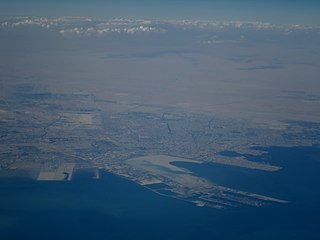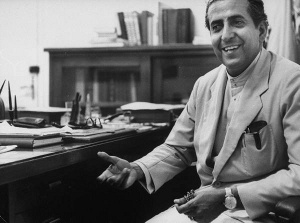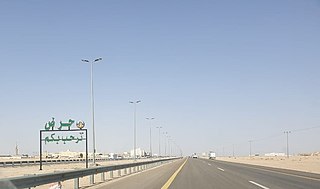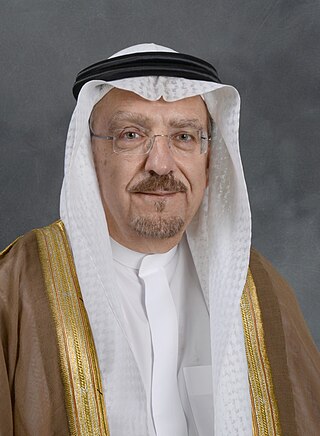
Saudi Aramco, officially the Saudi Arabian Oil Group or simply Aramco, is a Saudi Arabian public petroleum and natural gas company based in Dhahran. As of 2022, it is one of the largest companies in the world by revenue and has repeatedly achieved the largest annual profits in global corporate history. Saudi Aramco has both the world's second-largest proven crude oil reserves, at more than 270 billion barrels, and largest daily oil production of all oil-producing companies.

Ghawar is an oil field located in Al-Ahsa Governorate, Eastern Province, Saudi Arabia. Measuring 280 by 30 km, it is by far the largest conventional oil field in the world, and accounts for roughly a third of the cumulative oil production of Saudi Arabia as of 2018.

Dammam is the fourth-most populous city in Saudi Arabia after Riyadh, Jeddah, and Mecca. It is the capital of the Eastern Province, with a total population of 1,532,300 as of 2022. The judicial and administrative bodies of the province, in addition to the administrative offices of other minor governmental departments functioning within the province, are located in the city. The word itself is generally used to refer to the city, but may also refer to its eponymous governorate.

The Iraq Petroleum Company (IPC), formerly known as the Turkish Petroleum Company (TPC), is an oil company that had a virtual monopoly on all oil exploration and production in Iraq between 1925 and 1961. It is jointly owned by some of the world's largest oil companies and headquartered in London, England. However, today it is only a paper entity with historical rights and plays no part in the modern development of Middle Eastern oil.

George V. Chilingarian is an American-Armenian Professor of Civil and Petroleum Engineering at the University of Southern California (USC). He is one of the best-known petroleum geologists in the world and the founder of several prestigious journals in the oil and gas industry.
Shaybah, also called as Zararah, is a settlement dominated by a major crude oil production oil site, the Shaybah oil field, in Saudi Arabia, located approximately 40 kilometres (25 mi) from the northern edge of the Rub' Al-Khali desert. It is about 10 kilometres (6.2 mi) south of the border to Abu Dhabi, United Arab Emirates, which is a straight line drawn in the desert. It is 40 kilometres (25 mi) south of the eastern part of Abu Dhabi's Liwa Oasis.

Nikolai Alexandrovich Kudryavtsev was a Soviet Russian petroleum geologist. He is the founding father of modern abiogenic theory for origin of petroleum, which states that some petroleum is formed from non-biological sources of hydrocarbons located deep in the Earth's crust and mantle.
Frank Holmes, known affectionately by Arabs as "Abu Naft", was a British-New Zealander mining engineer, geologist and oil concession hunter. Following distinguished service in World War I, he was granted the title of honorary Major and was thereafter known as Major Frank Holmes in his civilian life.

Dhahran is a city located in the Eastern Province, Saudi Arabia. With a total population of 240,742 as of 2021, it is a major administrative center for the Saudi oil industry. Together with the nearby cities of Dammam and Khobar, Dhahran forms part of the Dammam Metropolitan Area, which is commonly known as greater Dammam and has an estimated population of 4,140,000 as of 2012.

Abdullah Tariki, also known as Red Sheikh, was a Saudi politician and government official. He was the first Saudi oil minister appointed by King Saud, and co-founder of Organization of Petroleum Exporting Countries (OPEC) along with Venezuelan minister Juan Pablo Pérez Alfonso. In April 1959 Time magazine described him as "the unquestioned spokesman of the new generation of Arab experts on oil."

Haradh is a large town and industrial city in the Ahsa Governorate in the Eastern Province of Saudi Arabia, approximately 150 kilometres (93 mi) southwest of Hofuf. Due to its location above the Ghawar oil field, several oil and gas wells, along with oil refineries are located in the area, all operated by Saudi Aramco. The village is also the site of one of the largest integrated dairy farms in the world, owned and operated by the National Agricultural Development Company (NADEC).

Discovery! The Search for Arabian Oil is a non-fiction book written by Pulitzer Prize winning American author Wallace Stegner.

Thomas Barger was an American geologist, explorer, miner, businessman and former CEO of the Arabian American Oil Company.
In petroleum geology, source rock is rock which has generated hydrocarbons or which could generate hydrocarbons. Source rocks are one of the necessary elements of a working petroleum system. They are organic-rich sediments that may have been deposited in a variety of environments including deep water marine, lacustrine and deltaic. Oil shale can be regarded as an organic-rich but immature source rock from which little or no oil has been generated and expelled. Subsurface source rock mapping methodologies make it possible to identify likely zones of petroleum occurrence in sedimentary basins as well as shale gas plays.

EnergyinSaudi Arabia involves petroleum and natural gas production, consumption, and exports, and electricity production. Saudi Arabia is the world's leading oil producer and exporter. Saudi Arabia's economy is petroleum-based; oil accounts for 90% of the country's exports and nearly 75% of government revenue. The oil industry produces about 45% of Saudi Arabia's gross domestic product, against 40% from the private sector. Saudi Arabia has per capita GDP of $20,700. The economy is still very dependent on oil despite diversification, in particular in the petrochemical sector.
Khurais oil field is an oil field in Saudi Arabia that went online on June 10, 2009, adjacent to the world's largest, the Ghawar trend. The Khurais field, with an area of 2,890 km2 and 127 km long, is located about 250 km southwest of Dhahran and 150 km east-northeast of Riyadh. Pilot-scale production at Khurais began in 1963, but the field was never fully developed.

Offshore oil and gas in the Gulf of Mexico is a major source of oil and natural gas in the United States. The western and central Gulf of Mexico, which includes offshore Texas, Louisiana, Mississippi, and Alabama, is one of the major petroleum-producing areas of the United States. Oil production from US federal waters in the Gulf of Mexico reached an all-time annual high of 1.65 million barrels per day in 2017. Oil production is expected to continue the upward trend in 2018 and 2019, based on ten new oil fields which are planned to start production in those years. According to the Energy Information Administration, "Gulf of Mexico federal offshore oil production accounts for 15% of total U.S. crude oil production and federal offshore natural gas production in the Gulf accounts for 5% of total U.S. dry production."

Saudi Arabian oil was first discovered by the Americans in commercial quantities at Dammam oil well No. 7 in 1938 in what is now modern day Dhahran.

Sadad Ibrahim Al Husseini is a leading Saudi oil and gas industry expert. He is most widely known for his achievements during his tenure at Saudi Aramco as the Senior and Executive Vice President for Exploration and Producing, and his current work on supply side risk; referred to by the New York Times as "one of the most respected and accomplished oilmen in the world".
The geology of Saudi Arabia includes Precambrian igneous and metamorphic basement rocks, exposed across much of the country. Thick sedimentary sequences from the Phanerozoic dominate much of the country's surface and host oil.














